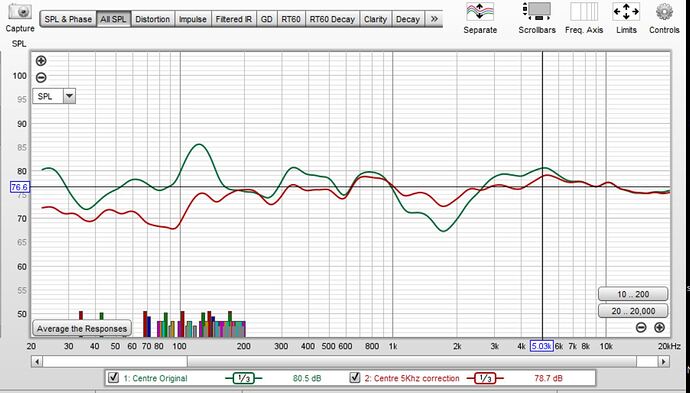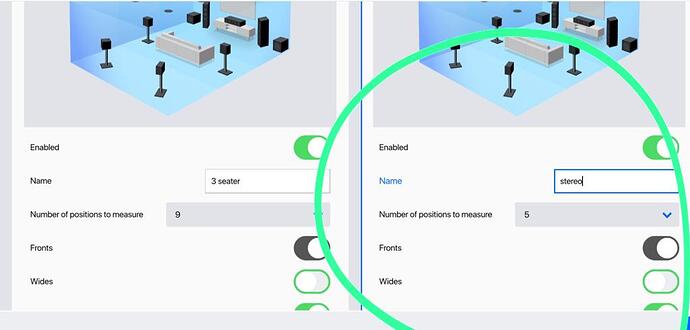My dealer has not yet received the AVM-90, he says it should get ready for next week.
Before purchasing the MP-40, I tested it with the following processors:
1: AVM-70
2: JBL SDP-55
3: ARCAM AV-40
As I noted before the AVM-70 did not have a significant advantage over the MRX-1140 so it was dropped from the chapter.
The JBL and the Arkam sounded to me very similar in terms of the Sunni quality which they presented and were very very good … very detailed separations and they produced a very impressive bass level and each of them had the DLBC of Dirac powered but I had a lot of issues regarding the stability of the device … Microphone not recognized by the calibration system, difficulty in uploading the calibration file to Mr. and even after uploading the file the file was not recorded in the device.
And the weird thing is that the problems were the same in both ARCAM and JBL SDP-55 so they were ruled out even though when the calibration was successful they sound amazing.
In the Lingdorf exam everything was easier and very simple and intuitive and in my opinion gave the best result … The bass management is amazing and very impressive and in my opinion the best I have heard in my life.
The separations are amazing and the whole combination of the bass and the overall result I got was very very very impressive to me … I am by nature very skeptical and every test I perform I perform it I completely rule out psycho-acoustic effects and comes very neutral in approach and uncompromising and makes no assumptions to any brand It is pumped marketing.
Honestly it was not too difficult a deliberation for me in making my decision and as evidence I chose the Lingdorf MP-40 which in my opinion gave my listening space the best results.
I believe and am sure that the AVM-90 is a crazy and amazing device which is going to be one of the best processors ever made. And congratulations to Anthem who continue to maintain a very high level and indeed is a super quality alternative to manufacturers such as:
LYNGDORF
TRINNOV
STORM-AUDIO
They deserve one huge nose.
yes you are correct in your assessment, i have the same findings, in terms of bass quality and integration, the Room perfect win hands down. No questions about that. It takes longer to run room perfect, but the end results of blending subs, and then integrating them with mains is very good. if you dont have acoustic treatment in your listening room, there is no doubt the room perfect will be the better choice. heck even with room treatment, it was still better
the AVM90 is really fantastic if subwoofers blend nicely, that is the biggest challenge IMO with anthem processors
both have their strengths… im quite neutral with my personal findings, as i have both units and will need to decide which to sell later
im still testing at this stage… i gotta make sure im absolutely satisfied before selling. now tempted to try EQ’ing all 4 subs as 1… but for the next few days, ill just be patient and try and do some listening before i proceed to do that next
Music sounds fantastic on the AVM90, dont need to use oppo 205 for music…
In my experience you will always choose the one that suits you best.
Now I will ask for your help in the post I created in Lingdorf’s group … I need help and guidance.
Thanks in advance Moshe.
Rest assured, ARC is applying correction filters accurately, so no issues. I’ll share the results of before and after ARC correction on the centre speaker. The centre speaker is tucked behind an AT screen, so there is some attenuation from the screen, that was easily corrected by ARC genesis. Happy to confirm the correction filters are working as intended
No problem mate, I’ll try my best
Thanks Roni for the detailed breakdown and analysis. This is the key takeaway I got from your review…this is not good as the key selling point or “differentiator” of the flagship AVM 90 compared to AVM 70 and the MRX 1140 is the ability to independently calibrate for 4 individual subs. It should “theoretically” correct each single subs from where their respective location is. If you have to resort to pairing up the 4 subwoofers as 2 pairs and worse is that you discovered the auto-phase correction feature are only correctly only 1 subwoofer from the 2 pairs (if I understand you correctly???), that is not good. Fortunately, in my case, I have 3 subwoofers and since I only have 2 independent subwoofer outputs, I am forced to do “pairing” and like you mentioned, it works great when ARC Genesis does its job.
As for more granular and finesse control over the freq, I guess the limit in the number of filters applied in ARC Genesis has something to do with it. There is a limit. My advice is NOT to overdo the correction of your freq beyond 5Khz. Stick to the Schroeder freq range correction will yield better results with tighter filters compared to a wider spread across full range correction (i.e. 20Khz).
Based on your last post, it seems to me that you have a winner in mind…and it rhymes with our “National A…m”…coincide with our upcoming National B’day. ![]()
So far, a lot of emphasis has been made on the subwoofer blending with the mains. Equally important is how the subwoofers are able to blend in with the rest of the speakers in the system…and based on my personal experience, ARC Genesis does it in an effortless manner and that’s what matters.
Can’t agreed more with that sentiment !!!
Don’t worry, the ARC Genesis is still at beta stage and hopefully user feedback and Anthem’s engineers will continue to perfect their algorithm in due course. The product life cycle of an Anthem product usually lasted 5 years, so expect more software updates to come along.
On a separate note, I will like to pay you a visit to see how your AVM 90 sounds at your place…PM me when you free. I’m usually free during the weekends, mostly Sat.
desray…you too have avm-90 or i am wrong?
Nope. I’m still using MRX 1140 and loving every minute of it. ![]()
You’re absolutely right … and if so then the AVM-90 is a significant leap in front of the AVM-70.
The main thing is that you are satisfied and that is the most important thing.
ok here is to clear the doubts. we can see the room correction is working as intended. ive specifically picked the centre channel, as that channel sits behind an acoustic transparent screen that attenuates sound to a certain degree, this speaker needed the most correction in the upper frequencies. and ARC didn’t disappoint.
the above shows the correction i have applied up to 5khz in .ARC3 file, the green line with a circle in red, shows the amount of correction applied. in this case, a boost in the 1.5khz to 2khz region
now see above, before and after ARC correction, you will observe that ARC applied a +6db boost between 1 to 2khz range, around 1.73khz. it didnt apply corrections after 5khz. observe and see how it cuts away the resonance peak at 120hz from the centre speakers. There is no limit to the amount of cut being applied on the peaks, it applies as much cut to meet the 75db target line. However, when it comes to boosting, it only applies a maximum of +6db boost.
This should clear any doubts. It is applying filters correctly according to the respective speakers, so i have verified that. No issues, its doing its job.
You can see clearly from the amplitude graph above, original in green, post ARC in Red. So much better with correction applied
Errr… I don’t think you understood my perspective.
Let me walk thru the workflow and hopefully you can see my perspective…
After i go thru the whole 5 position measurements and get all the nice graphs…
If I further adjust the target curve, it will do a calculation to create a ARC adjustment which is the green line as you mentioned.
But it does not run any further measurement does it?
In my case, it does not, therefore, the “corrected curve” is theorectical (ie predicted as I call it) - is the actual result “as predicted”? >> i’m just saying this is the not validated by any measurement by ARC post calc,
I understood about the range frequency that we would like to apply adjustment (ie default is up to 5kHz and we are free to adjust it as per each preference)
I’m unaware of this boost limit… this might explain the less than optimum results.
For sure there is some freq response adjustment - just not as perfect as in their visualization.
expectations expectations…
Yes, ARC only boost up to +6dB.
No room correction software in the world does that validation. All room correction softwares work the same, they do the necessary correction and applies the necessary filter. They do not validate it with another process. That is up to the user to verify with a 3rd party software , in this case REW. It is the same with audyssey, room perfect, Dirac live, accueq, YPAO.
Which software you have used that has that validation process ?
JBL’s arcos ? I don’t recall seeing any room correction software that has a separate process validating corrections applied post EQ
I don’t think even the high end storm , trinnov has that validation process, coming in at > $10k-$20k type of processors. I doubt anthem will provide that.
But maybe you can do this if you want to validate it.
Maybe try and apply corrections first, then go back to quick measure and see if the target curves are what you are expecting ?
That is one way to validate I suppose ?
Not sure about Trinnov Altitude has that post cal measurements, maybe bro wind can chime in on this. It looks impressive with a slew of features and I vaguely recalled he mentioned pre ànd post measurements can be displayed for side by side comparison. I could be wrong.
@Ronildoq, did you add miniDSP into the connection chain? I don’t recall you mentioning anything in your posts.
yes, pre post measurements can be displayed, the before and after. That is already available with Anthem. But from what im reading from Ricky’s point of view, he is looking at how the RC software results are validated. A separate process to validate the corrections applied. Otherwise its theoretical.
I think the only logical process to validate corrections applied is vide a 3rd party software, software other than the one provided by the manufacturer, like REW, ARTA, Rightmark, Room Analyzer Pro etc to name a few.
But good news for Anthem users, you can actually validate this using the Quick Measure process, to quickly look at amplitude response again post EQ. but you cant overlay and compare the pre and post measurements like REW, you can just sort of have a quick look
i havent added the minidsp 2x4hd. i am trying to avoid using RCAs preout @ 2v vs XLR preouts using 4v. i might use it for BEQ and crowsons only. havent gone there.
last night quickly listened to music and watched the first movie, Minions part 1, solid!!
it is nice to set up multiple profiles, including Stereo 2.2, Multi channel music, 30cm mic placement option, and 3 seater option. The processor uses 19 channels sabre 9038pro, fantastic, dont miss setting up multichannel music for atmos. Its very solid. I prefer the sound with 30cm mic placement option vs 60cm mic placement option.
for stereo profile above, switch off all channels and keep only fronts and subs on. Somehow it sounded louder with this option. ill need to check on that as well, levels. havent come to that stage
Soundmix engineer’s perspective when mixing below…



